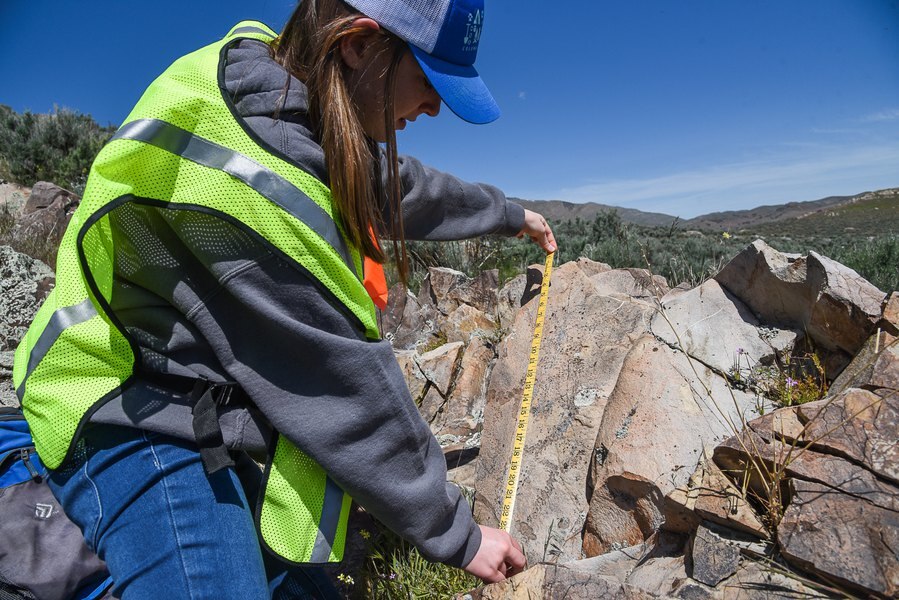Students work to document rock art at a preserve near Utah Lake to help it win national recognition even as new threats emerge

(Francisco Kjolseth | The Salt Lake Tribune) Alison Green, 12, uses a tape measure to make notes on ancient petroglyph at the Adelbert Doyle Smith Family Archaeological Preserve on the west shore of Utah Lake. Middle school students are participating in a program to nominate the area as an archaeological preserve on the National Register of Historic Places.
On a recent visit to Utah Lake’s west shore, Alison Green scrutinized sandstone outcrops, measuring lines chiseled into the stone by ancient hands, then doing her best to replicate them on gridded sheets.
The 12-year-old girl from Sandy inspected one petroglyph cut into rock hundreds of years ago by Fremont Indians.
“It shows the person has braided legs and that could be a birthing scene,” she said. “That could mean it was a fertile area.”
Green was among two dozen middle schoolers from Sandy’s Blessed Sacrament Catholic School doing archaeological surveys at the Adelbert Doyle Smith Family Preserve as part of an effort to list the 196-acre site on the National Register of Historic Places.
“The kids are doing the work the way an entry-level archaeologist out of college would,” said John McHugh, a science teacher at Blessed Sacrament leading the expedition. He calls the school’s archaeology club, which he oversees, the Shovel Bums after the moniker given to rookie archaeologists who do the grunt work at excavation sites.
On this day, McHugh was managing at least 20 schoolchildren, with the help of parent chaperones and a few adult archaeology buffs, as they roamed rugged terrain above Utah Lake’s azure water, armed with clipboards, pencils and measuring tape. Their mission: to record crucial data for many of the 240 known rock art panels at the preserve, named for land’s former owner.
In 2013, Smith’s descendants donated the property to The Archaeological Conservancy, which now maintains it as a preserve open to the public, according to the nonprofit’s Southwest regional director, Jim Walker. The Smith preserve is one of more than 500 the conservancy oversees in 46 states.
“All are available for research under controlled conditions. We don’t do research; we are just in the preservation business,” Walker said. “We like to see our preserves used for educational purposes and get the point of archaeological preserves to the audience that is most receptive, and that is kids.”
The conservancy maintains a handful of smaller preserves in Utah: Three Chacoan sites in San Juan County, including Hedley and Carhart pueblos; a Fremont village near Paragonah; two sites adjacent to Jackson Flat Reservoir near Kanab; and an Anasazi site near the Virgin River.
The Smith site is located off State Road 68 about eight miles south of Saratoga Springs. Visitors can park a quarter-mile east of the highway at a trailhead equipped with a kiosk that provides interpretive information and a trail map.
The site’s key occupants were Fremont Indians, whose largest known villages have been recorded on the opposite side of Utah Lake near the Provo River. But other than a ring of rocks, few signs of permanent habitation can be found. Perhaps it was a seasonal outpost where fish and game could be easily harvested, but it would be hard to ever know for sure.
Before the land was acquired by the Smith family 60 years ago, it had already been stripped of its artifacts, according to Steve Manning, a member of the Utah Rock Art Research Association who conducted the first formal survey of the Smith preserve’s petroglyphs in 2014. But the site remains scientifically significant, which the Smith family recognized, with most of the petroglyphs still unblemished except for the lichens creeping over them.
“There is something there from about every culture in the vicinity,” said Manning, a retired University of Utah chemist, “stuff from the oldest petroglyphs there are [in Utah] to about the time that the pioneers arrived. There is a continuous record for that entire time period. It dates back about 10,000 years.”
Similar petroglyphs abound nearby on the east slope of the Lake Mountains rising above the lake, much of them on land administered by the Bureau of Land Management, but these cultural treasures have not fared so well. Until recently, this land was the scene of unmanaged target shooting. Shooters not only left tons of “trigger trash,” including shot-up appliances, televisions and vehicles but also used rock art panels as backstops or props for paint cans that served as targets, causing irreparable damage.
After stray rounds triggered a wildfire that nearly burned into Saratoga Springs in 2012, the BLM closed land nearest to the highway to shooting, but abuses continued and petroglyphs continued to suffer.
“Unfortunately, the only places left open contained all the rock art,” said Randy Griffin, the Smith’s preserve’s volunteer site steward.
Target shooting on the nearby federal land has dropped off substantially since the BLM implemented a new management plan last September that largely put an end to unregulated shooting on federal turf in this area.
On county-owned land adjacent to the preserve’s northern boundary, however, unsafe use of firearms and other abuses have continued, putting at risk visitors to the preserve and its resources, according to a formal complaint Griffin submitted Thursday to the Utah County Commission.
The county recently acquired this land from The Church of Jesus Christ of Latter-day Saints, which had long tolerated public access. Among the latest string of incidents, a group of unauthorized campers, one with a handgun dangling from his back pocket, ambled by several “no trespassing” signs onto the Smith property May 4.
“At one point, I observed the individual with the firearm pick up an object off of the ground and hand it to another person in their group who pocketed it,” wrote Griffin, a retired BLM law enforcement officer who used to patrol public lands here. “At another point, the individual with the firearm was seen carving on a large rock with a pocket knife. When this group exited the preserve, two of the individuals gathered firewood that they carried back to their camp.”
Griffin has seen other users of this county-owned land drive and park on the shore, abandon campfires, leave piles of human waste, and shoot toward the preserve.
“We cannot invite the public onto the preserve, especially young children, if we reasonably can’t provide a safe and enjoyable visit,” Griffin’s letter continued. “The activities emanating on the county’s property adjoining the preserve can and, if not corrected, will impact what the Conservancy will be able to offer to school groups like these as well as the general public if the county does not act immediately to restrict or regulate what uses are allowed on the county’s property adjoining the preserve.”
Regardless of what transpires next door, the Smith preserve resources will stay under the watchful care of Griffin and several other volunteers in the hopes of ensuring it remains a community asset and a safe repository of timeless images.
“The rock art here isn’t spectacular in and of itself, but it is some of the oldest rock art in the state. There’s a lot of great base-curvilinear stuff out here, and some really early Fremont,” said Utah Rock Art Research Association member Nina Bowen. “It shows the use of the area. The Smith preserve in particular is so unspoiled that it really gives the kids a chance to see what it could have been like in ancient times.”
Some of the images show humans in what appears to be ceremonial garb or engaged in hunting or ritualist activities. Others depict snakes, bighorn sheep and other animals. Another resembles a fish net, perhaps a reference to the bounty of the now-gone trout that once plied Utah Lake in great abundance, replaced by the invasive carp that occasionally breach the surface as the Blessed Sacrament students went about their work.
Archaeologists with a trained eye can estimate the age of Smith’s petroglyphs from how much mineralized patina has returned to its chiseled surface. The older glyphs have a greater degree of “repatination,” according to Shawn Lambert, who heads the public archaeology program for the Utah Division of State History.
On the day of McHugh’s field trip, his students inspected dozens of panels marked with small magenta flags, basically retracing Manning’s earlier work. They entered data on each petroglyph on a standard form, recording the size, its precise GPS coordinates, the degree of repatination, directional aspect and slope of the rock surface, its condition and other information.
The images’ meaning was not among the data they were to collect, but that didn’t stop the young archaeologists from pondering as they described the petroglyphs they were documenting.
Fifth grader Maggie Williams tried make sense of an abstract image she was committing to paper.
“It looks almost like a hand that has three fingers,” she said. “We don’t have to be da Vinci; we just need to draw it as close as we can. It can still be ugly.”

